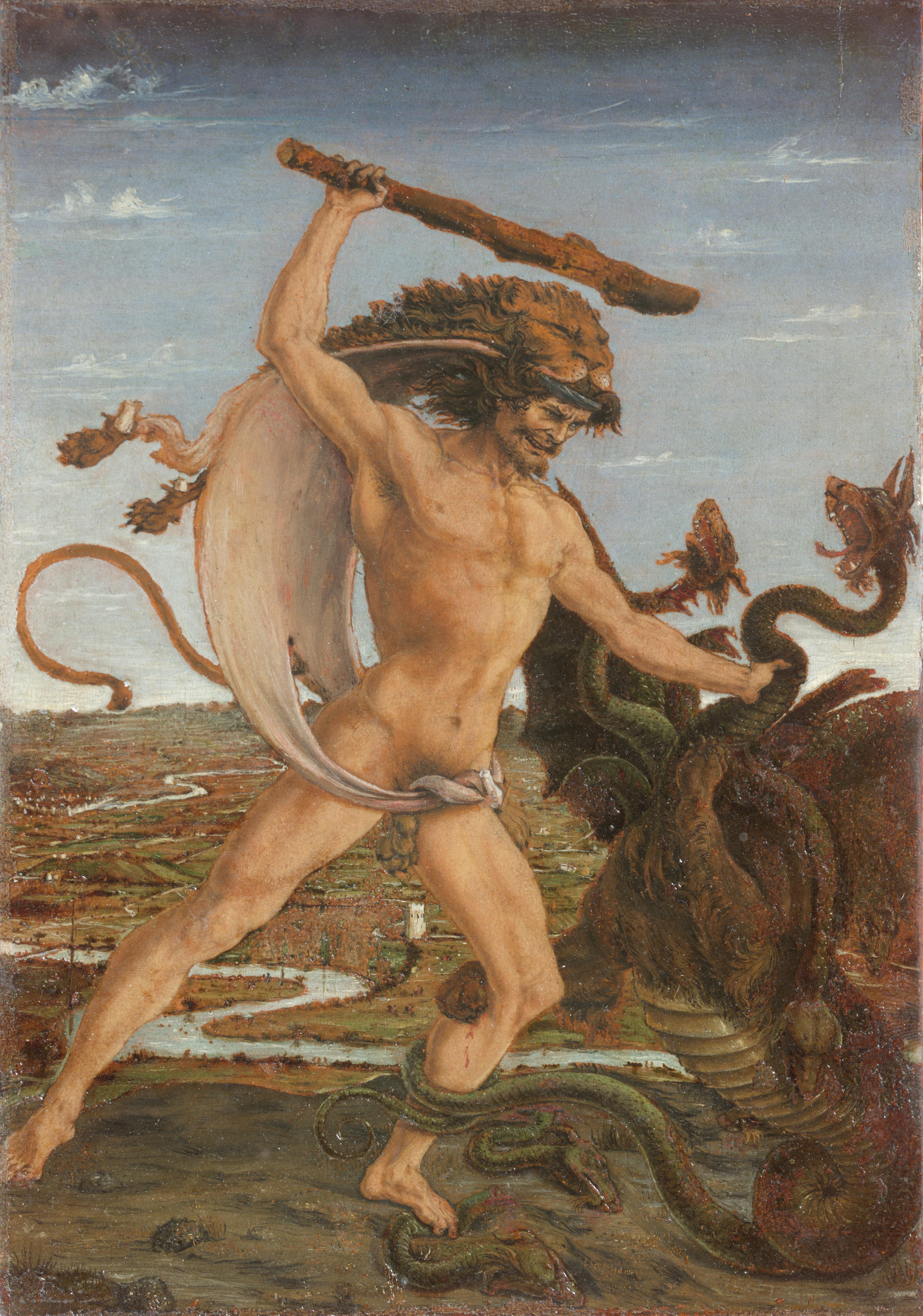Hercules and the Hydra
Antonio Benci known as Antonio del Pollaiolo o del Pollaiuolo (Florence 1431-Rome 1498)
Heracles, or Hercules, the hero of Greek mythology is faced with the hydra, a seven-headed monster that terrorized the city of Lerna. It is one of the twelve superhuman feats, called the Labours, that Hercules performed to atone for having killed his wife and children in an outburst of anger provoked by the goddess Hera.
Devoid of weapons, Hercules wields a rough wooden club, and he is covered only by the skin of the lion he had killed in Nemea on his first feat. The muscular body emphasizes the strength of the hero fighting against the monster. The dramatic force of the scene is accentuated by the sense of movement suggested by the prevalence of serpentine lines and the swelling of the lion's skin, which appears like a sail blown by the wind, while the hero's face is transfigured due to the tension of the fight. Hercules seems to dominate the flat landscape behind him, characterized by the marshes inhabited by the hydra.
Despite its small size, the painting is full of details and executed with extraordinary skill. Together with the panel depicting Hercules and Antaeus (Inv. 1890 no. 8268), it was attributed to Antonio del Pollaiolo, an artist, elder brother of Piero, who practiced sculpture and goldsmithing with equal skills. Ancient sources reported that Antonio executed three paintings on canvas for the 'great hall' of the Medici palace in Via Larga in Florence, depicting Hercules and the Nemean Lion, Hercules and the Hydra, and Hercules and Antaeus, which are now lost. The hypothesis that the two panels, which are preserved at the Uffizi, might have been preparatory models or copies of the Medici cycle is considered untrue, but in any case, they prove Antonio's deep knowledge of the Labours of Hercules, a theme which he also used when trying three-dimensional bronze sculpture.
The two Uffizi panels were documented in Florence in 1609 among the collection of Benedetto di Bartolomeo Gondi. At that time, the two small paintings formed a closable diptych, similar to a book. It is not known when they became part of the collections of the Grand Dukes of Tuscany. They were in the Pitti Palace in 1794 and came to the Uffizi in 1798. During the Second World War, the two panels were stolen by the German army and taken to Germany. After a long search, they were found in 1963 in Pasadena (USA) by Rodolfo Siviero and have been displayed at the Uffizi since 1975.
A. Tartuferi, in La stanza dei Pollaiolo, a cura di A. Natali e A. Tartuferi, Firenze 2007, pp. 114- 117; C. Gulli in Dal Giglio al David. Arte civica a Firenze fra Medioevo e Rinascimento, a cura di M. M. Donato e D. Parenti, Firenze 2013, pp. 244-247; A. Cecchi, in Mattia Corvino e Firenze. Arte e umanesimo alla corte del re di Ungheria, a cura di P. Farbaky, D. Pòcs, M. Scudieri, L. Brunori, E. Spenkner, A. Vègh, Firenze 2013, pp. 230-231; F. Siddi, in Antonio e Piero del Pollaiolo. “Nell’argento e nell’oro, in pittura e nel bronzo…”, a cura di A. Di Lorenzo e A. Galli, Milano 2014, pp. 192-196
Hercules and Antaeus
Antonio Benci known as Antonio del Pollaiolo (Florence 1431-Rome 1498)
